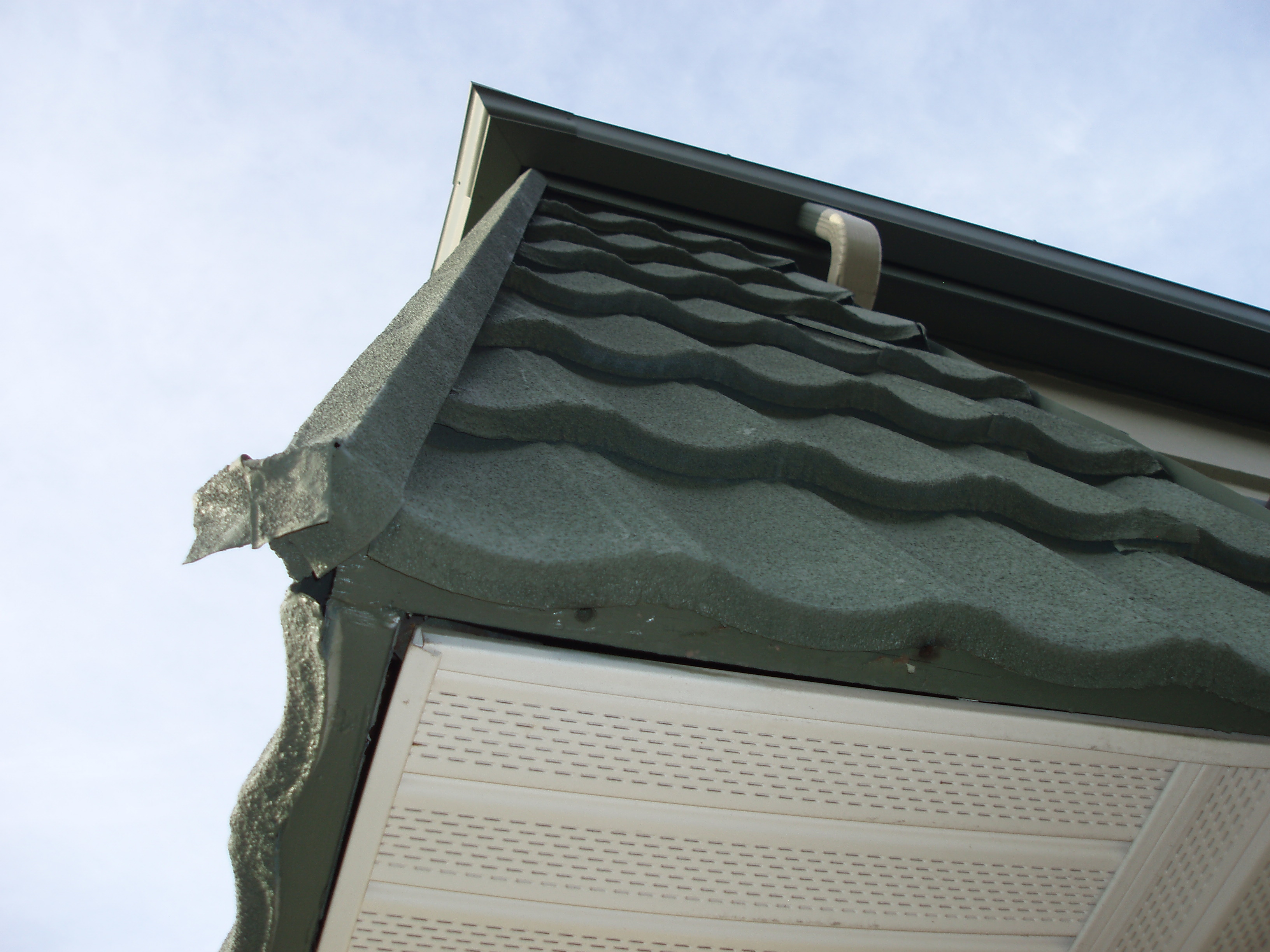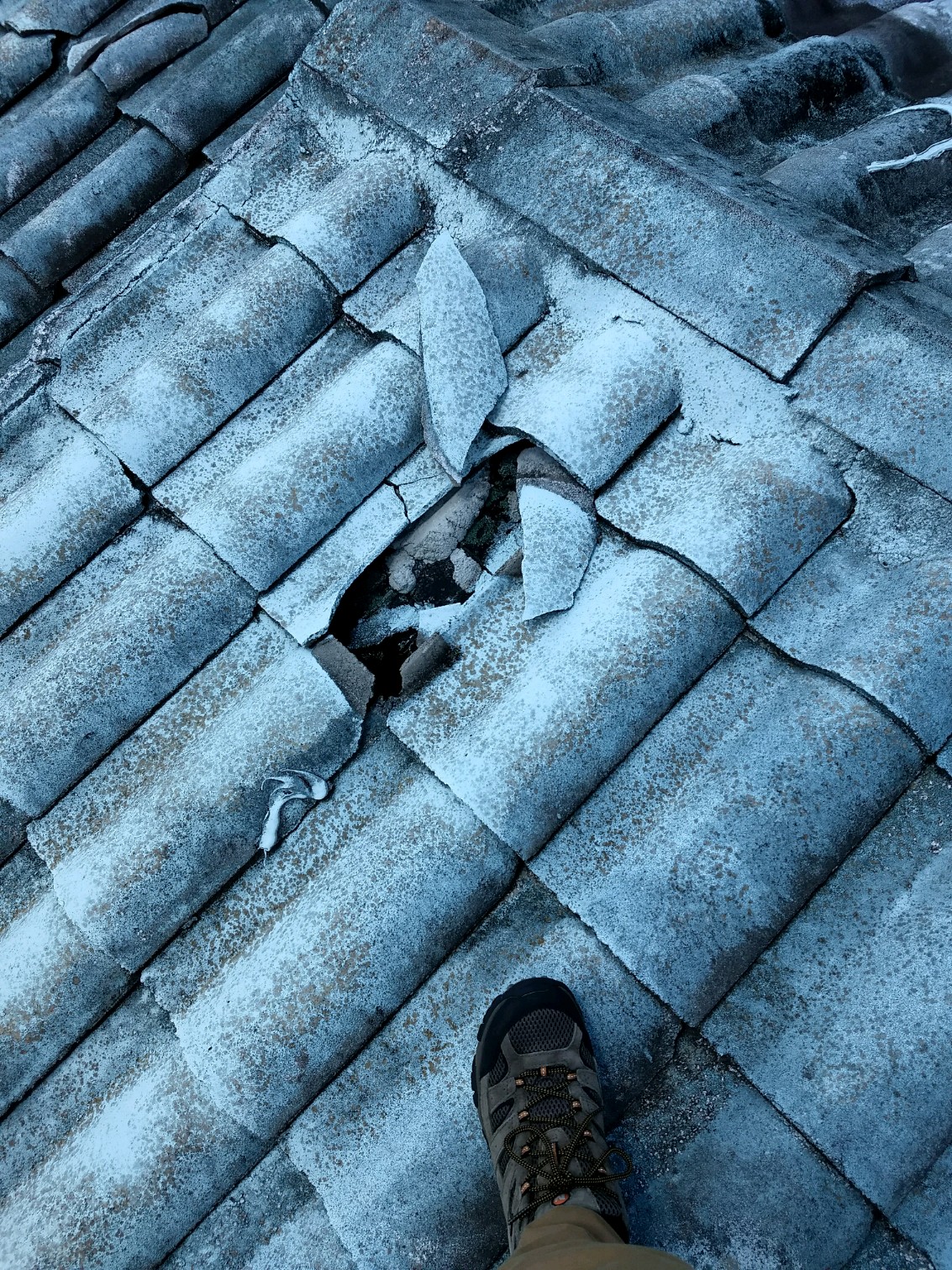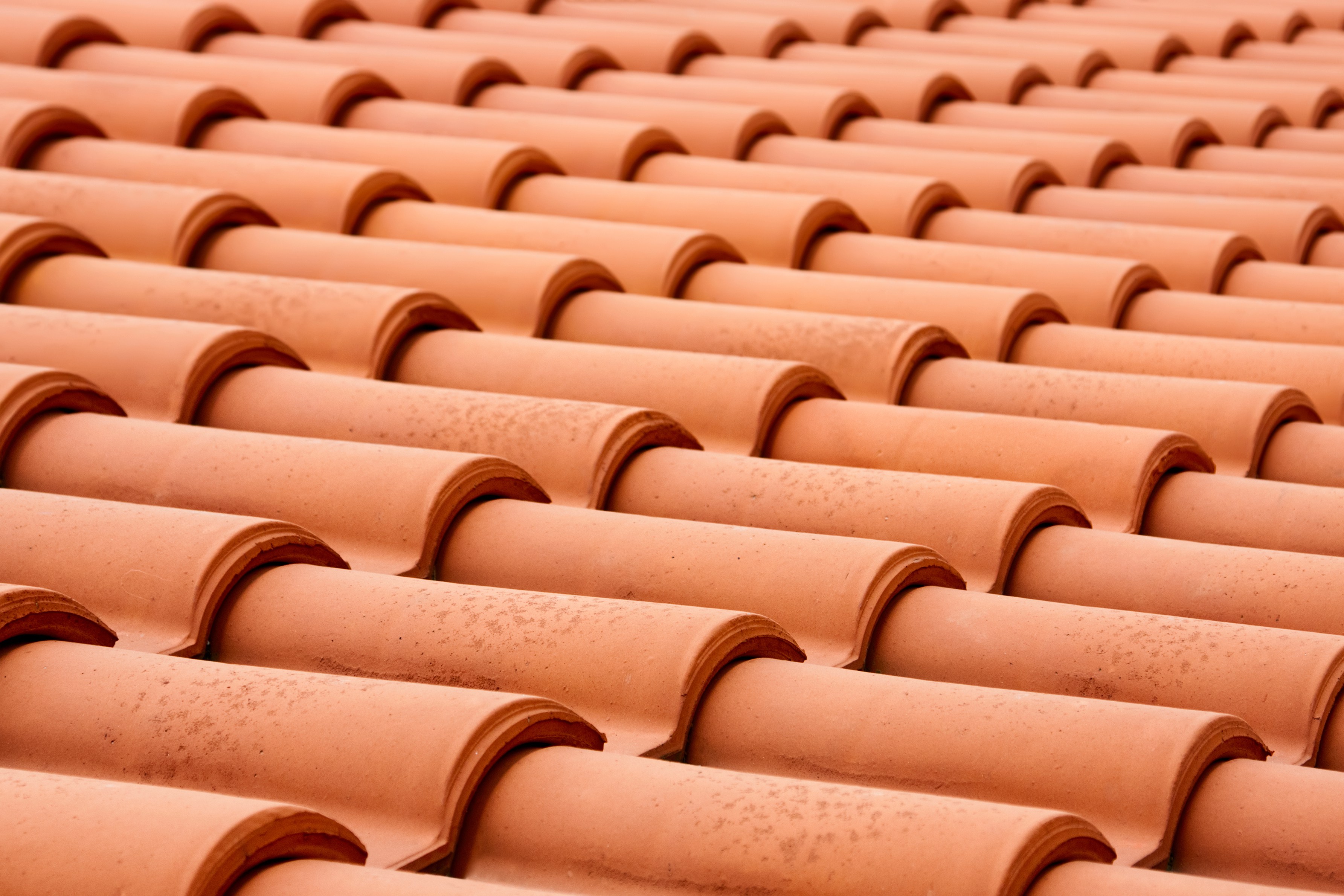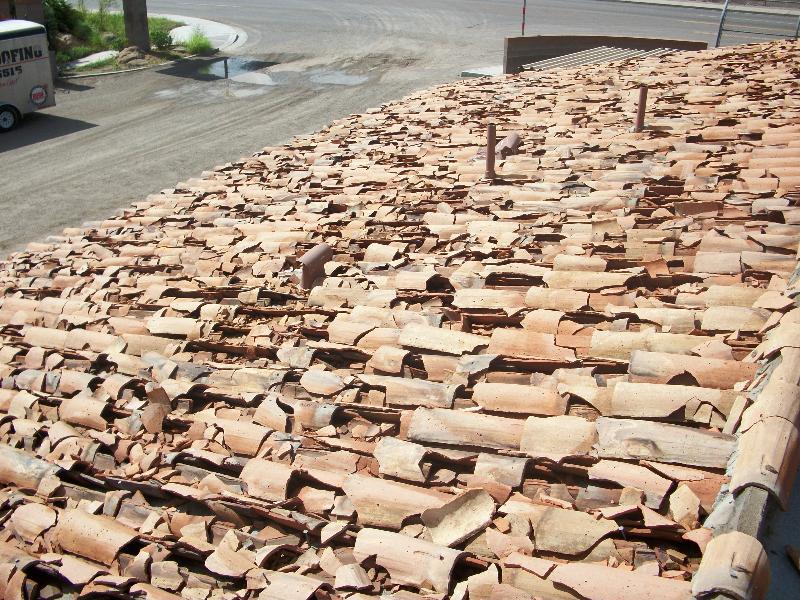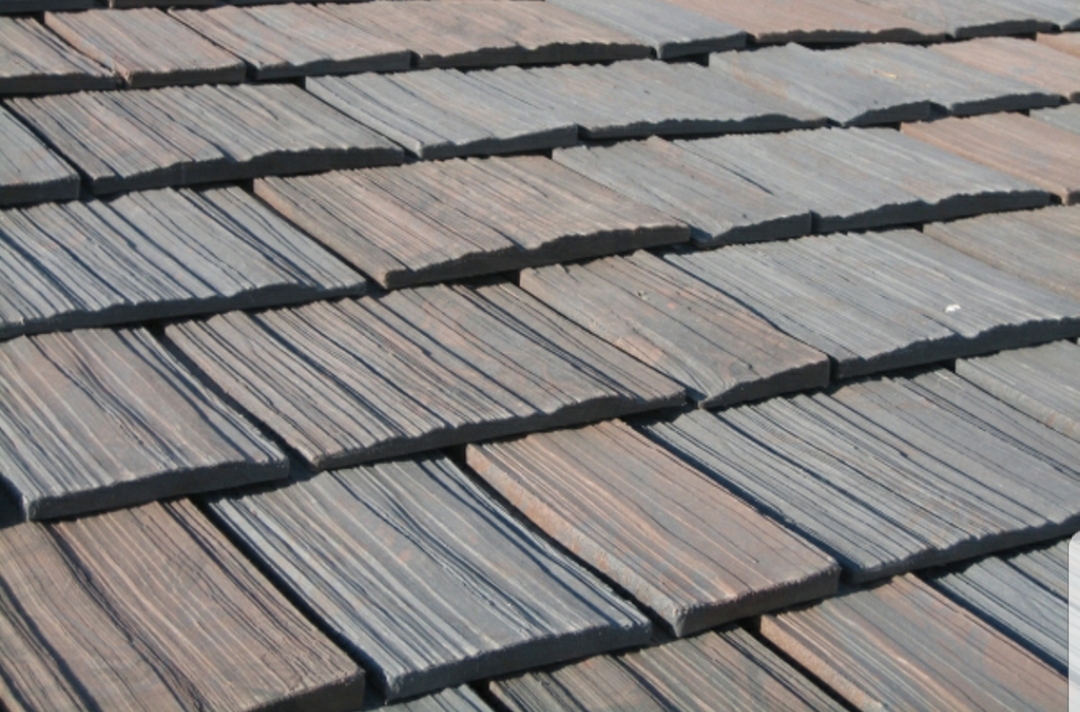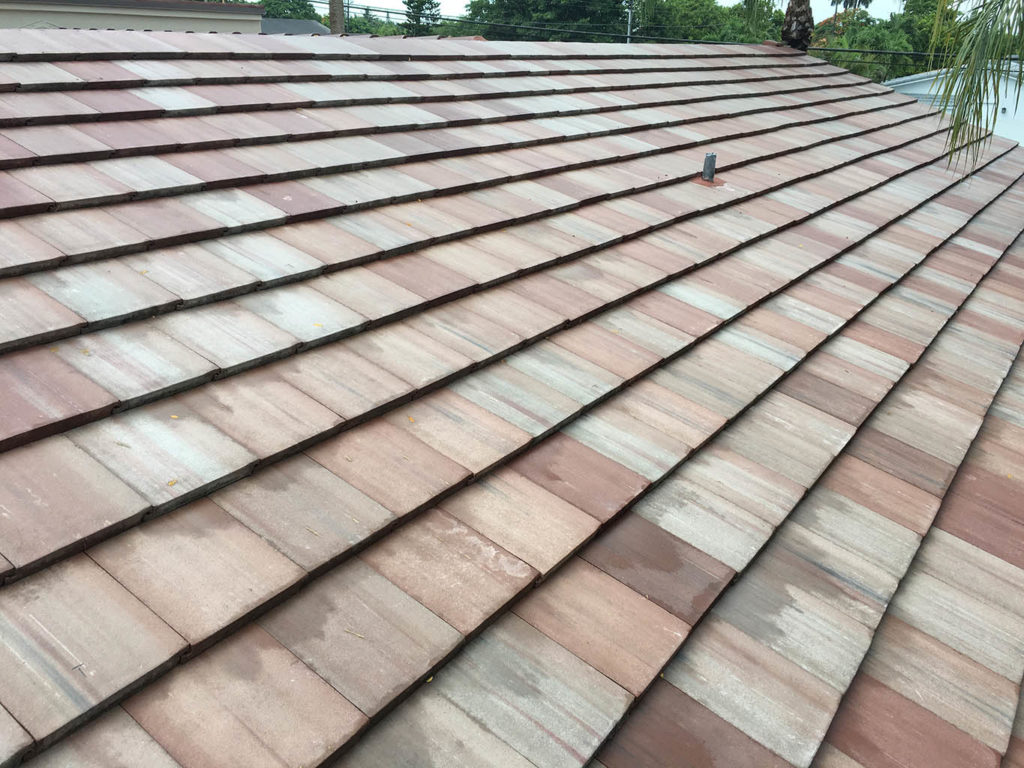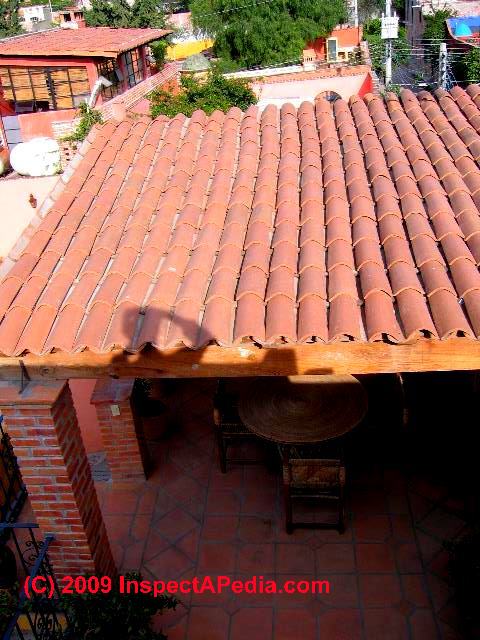The photo attached is Mansard roof. The tile is a composite tile which is basically plastic. It has a nice face to it, making it look like real tile. It is interlocking the way it is designed. The roof, being a Mansard, has a very high slope that I did not measure, but probably a 24 12.
Tiles come in many shapes and sizes and compositions. There is your regular clay tile, that should be properly dried in a Klin so the clay as a proper drying period. This is important so that the clay when it experiences the thermal changes of freezing and cooling it does the tile does not break and crack. There are many tile types. Interlocking, high profile and lower profile clay, cement tiles, etc.
This is an image of a Concrete tile roof that is original to the home which was 41 years old. As you can see there are damaged tiles on this roof that are far gone from repair and should be replaced. This roof has had its paint baked off by the intense Florida sun and even had signs of someone trying to repair some tiles previously. This was only one of the many many broken pieces.
There are many different installations for clay and concrete tiles. According to the image ““S” Style Clay Tiles” This S style clay tile should be installed with two nail holes at the upper left of the low point of the tile.
This is an image of a 13 year old Spanish-S concrete tile roof. This roof was installed immediately after the 2005 hurricane that passed through South Florida causing much damage. This tile was not designed to keep water from going under the tile. It does not have a rain check line and it has a diagonal cut in the upper right corner which never gets completely covered by the overlapping tile above and it is a weak tile. This tile needs a water proof roof under it such as a 90 lb slate hot mopped over 30 lb felt tincapped and was designed to keep the sun, harsh weather and most rainfall from deteriorating the organic felts. It was used for decades as a cheaper alternative to the more expensive, heavier weather checked tiles but is not used much today.

Mastering Roof Inspections: Tile, Part 1 by Kenton Shepard and Nick Gromicko
The most common roof tiles made today are made of clay or concrete. Less common are metal and plastic tiles. Tiles come in 3 main profiles - low, medium and high. Low tiles are flat or almost flat. They are laid in shingle fashion so that the butt joint of 2 tiles centers on the middle of the tile below. Medium profile tiles are s-type and shallow clay or concrete pan tiles with some having interlocking edges that align the tiles and to a degree serve as water check lines. High tiles are barrel type with separate or integrated pans which are overlapped by the covers. Bird stops, either manufactured such as metal or rubber, or made on the job such as with tile cement, should be installed at the eaves of medium and high profile tiles roofs. Concrete and clay tiles are are class A rated, Class 3 and 4 hail resistance rated and rated to !25 mph wind resistance if installed properly.
Clay tiles can be a very long lasting roofing material. When installed properly and void of manufacturing defects, tile roofs can last decades. It is important to remember never to walk on a tile roof to inspect it, rather look through binoculars from an elevated position if possible.
I read the article written on Bat Infestation. Bats can get into places as small as a 1/2 inch opening. While their guano is a valued fertilizing agent, they carry with them many harmful diseases at times, including rabies. So it should go without saying, if there is a bat infestation problem, they need to be removed.
Hail is a *****. I have never witnessed a more severly hail damaged roof than this. Usually I look for damaged tiles, in this case locating good ones proved to be impossible. The entire roof needs stripping and re-tiling. Even the roof deck was damaged in places but was better evaluated after all tiles were removed.
I stayed with the tiled roofing theme. What I learned is that tile roofing is not limited to clay or asphalt. In addition, there are many, many styles that mimic everything from wood to shingles. It was very educational to learn about modern composites and how we are not limited to simple tiles as we have in the not so past, past.
section of the roof, covering a patio, done with a different style of clay tile, showing sings of spalling and flacking. Some type of product was applied, but deterioration continues, whole section under room bellow showing moisture penetration. Service recommended.
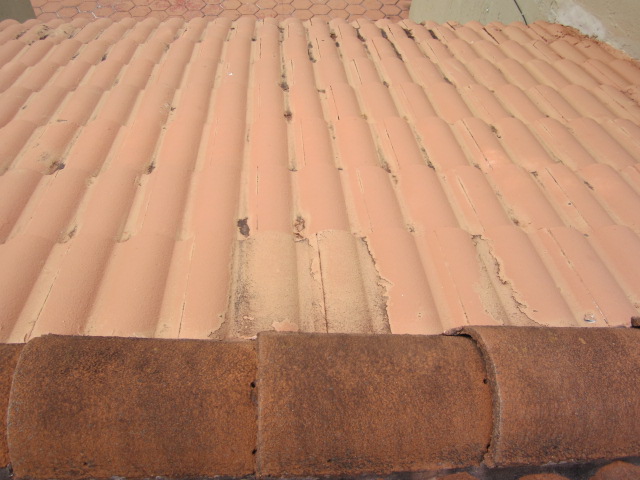
section of the roof, covering a patio, done with a different style of clay tile, showing sings of spalling and flacking. Some type of product was applied, but deterioration continues, whole section under room bellow showing moisture penetration. Service recommended.
This photo shows a composite roof tile installed on the dwelling roof. From the street theses tiles appeared very much like some type of concrete roof tile. Upon closer inspection it was clear that they were a composite and as it turned out, they were formed from recycled plastic.
I found the article I read on roof underlayment to be extremely interesting. The most interesting item of note was that because of the technological advancements of refining crude oil, there is less asphalt as a byproduct left over in the process. this has caused a shortage of asphalt and there for a shortage of asphalt impregnated, or “felt” paper.
During the construction of a new roof are several factors that must be considered in order to support the different conditions that this surface suffer. Determining of the place, it must resist the high and low temperatures to which it will be exposed, rain, winds and different atmospheric conditions. The selection of correct materials and the appropriate installation will reduce the damage that both the weather and unexpected accidents may cause. An adequate inclination, the correct installation of flashing, drainage and treatments of ceilings installed under the manufacturer’s expectations, are of vital importance so that it can last as long as it is expected to last
One of the concerns we face every month is how to reduce the energy consumption in order to lower the cost of energy in our bill. There are several easy ways we can do to achieve a lower energy consumption. The way in which we cool or heat our house is one of the highest consumptions we have, the installation of fans will help the best ventilation and reduce the use of A / C in a big way. A wood or pellet stove will help us to have a pleasant temperature in the cold seasons without the need to turn on the central heating.
The tank-less water heater, the replacement of the incandescent lights by LED lights, the sealing and insulation of door, windows and any air lock is very important, this way we avoid that the A / C work of more. These are just some practices that we can implement to achieve a significant reduction in electrical energy.
This a clay tile roof on a low slope. This could cause moisture leaking, and should be further evaluated by a qualified roofing contractor. Also the tiles are installed horizontally instead of vertically in proportion to the slope of the roof this could cause water ponding.
The most common materials for roofing tiles, are clay and cement. Fibrous cement was once used but is no longer acceptable due to asbestos concerns. also recylcled plastics and metals can be used to produce roofing tiles. Roofing tiles come in a variety of styles and profiles. They are genrally classified as flat low and high.
Clay tiles. They are clean the rake edge looks installed properly, corners look properly sloped to gutters and windows are sealed. There is no apparent damage to caps from another angle the valley looks in good condition and all the gutter is connected and attached properly
“FSBO” pros and cons
When selling a home using an agent vs not would be a time and knowledge based decision. Being on a time frame, using an agent will certainly help cut the time, as they are also working with buyer agents. Knowledge an agent has also keeps the seller out of most potential lawsuits, or getting burned on price of home being incorrect. Of course a seller and buyer agent highly recommend get inspections. its usually the most stressful time in the process of buying or selling as most home owners don’t have a great comprehension of the scale a house inspection takes.
